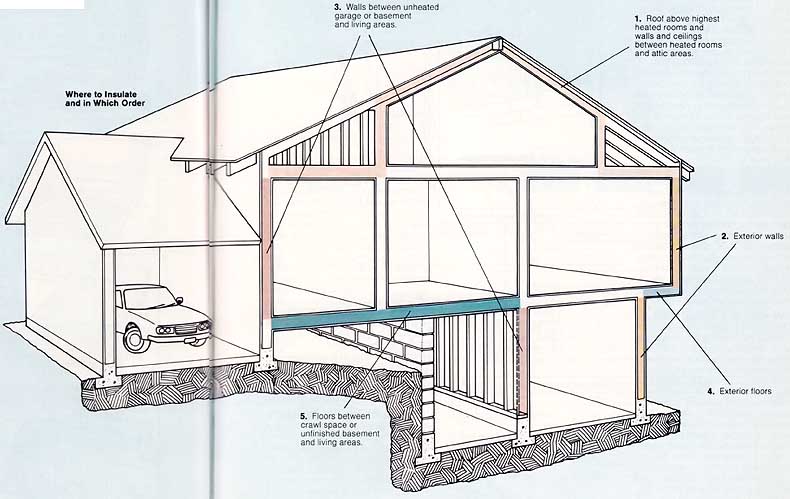There are two cardinal rules for insulating a house:
Surround the space you occupy and heat; and start at the top. Let’s examine these rules.
• Surround the space you occupy and heat: If you think of your house as a more or less permeable envelope containing the space you live in, then the objective of insulating becomes clear: to make that envelope less permeable and more completely contained.
Ideally, you should insulate every surface between your house and the outside world, including any surface that meets an unheated or uncooled portion of the indoors on one side and your living space on the other. These surfaces define the boundaries of your energy flow, and therefore require your attention if you are to reduce energy leaks. These boundaries include every exterior wall (including the walls that connect different portions of a split-level building); and every wall, floor, or ceiling between your living area and an un heated portion of the indoors (this includes the porch, garage, attic, basement, utility room, crawlspace, cellar, and overhung toolshed, as well as un heated attic floors, finished basement walls, finished attic ceilings and knee walls, and dormer ceilings and walls).
• Start at the top: Since heat rises, it stands to reason that it will leak out of the top of your house first. and because the summer sun beats down from over head, heat also enters your house from the top, at exactly the time of year you don’t want it. Therefore, the place to start insulating your home is the roof above your highest heated room, or the floor of your unfinished attic. From there, work your way down to exterior walls, and finally to floors. Give priority to floors that are, in fact, exterior lower walls (such as the floor of a cantilevered room above a carport), and to floors that have drafts or wind blowing under them.
The drawing below indicates where to insulate a house, and in what order you should do so.
Bear in mind two things: First, you don’t have to do all your insulating at once. You can take it a ceiling, wall, or floor at a time. You don’t even have to do it all this year.
Second, remember the law of diminishing returns: At some point, the money you spend on insulation is no longer being recouped in energy savings, and you’re making a $100 improvement for a $1 per year return on your investment.
So before you run out and buy a few acres of fiberglass batts, see how much insulation you already have. Then calculate the amount of additional insulation that will bring you the best return when placed in the part of your house that needs it most. If you have any insulation at all in one strategic area and none in another, you’ll probably do better to add some insulation to the place where you have none than to put in additional insulation.

Where to Insulate and in Which Order: 1. Roof above highest
heated rooms and walls and ceilings between heated rooms and attic areas.
2. Exterior walls. 3. Walls between unheated garage or basement and living
areas. 4. Exterior floors. 5. Floors between crawl space or unfinished basement and living areas.
Next: How Much Insulation Do You Need?
Prev: Insulating the House